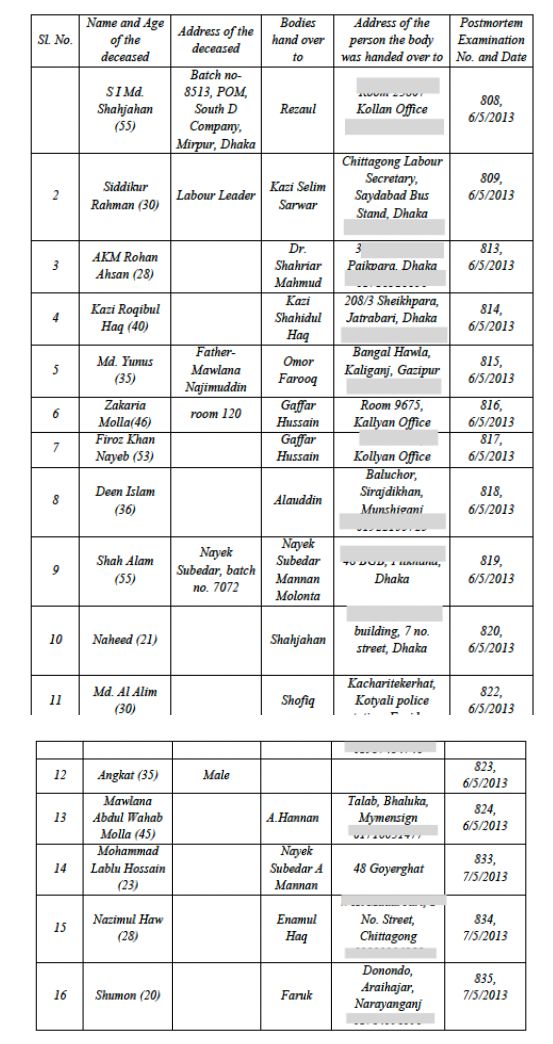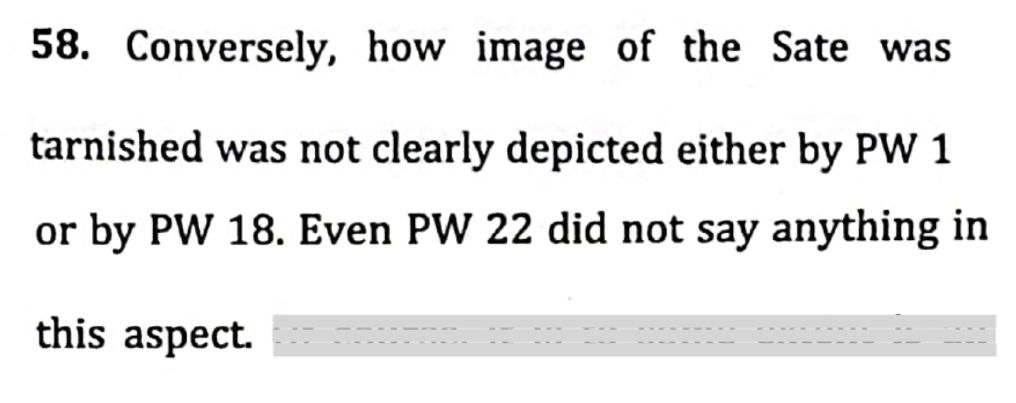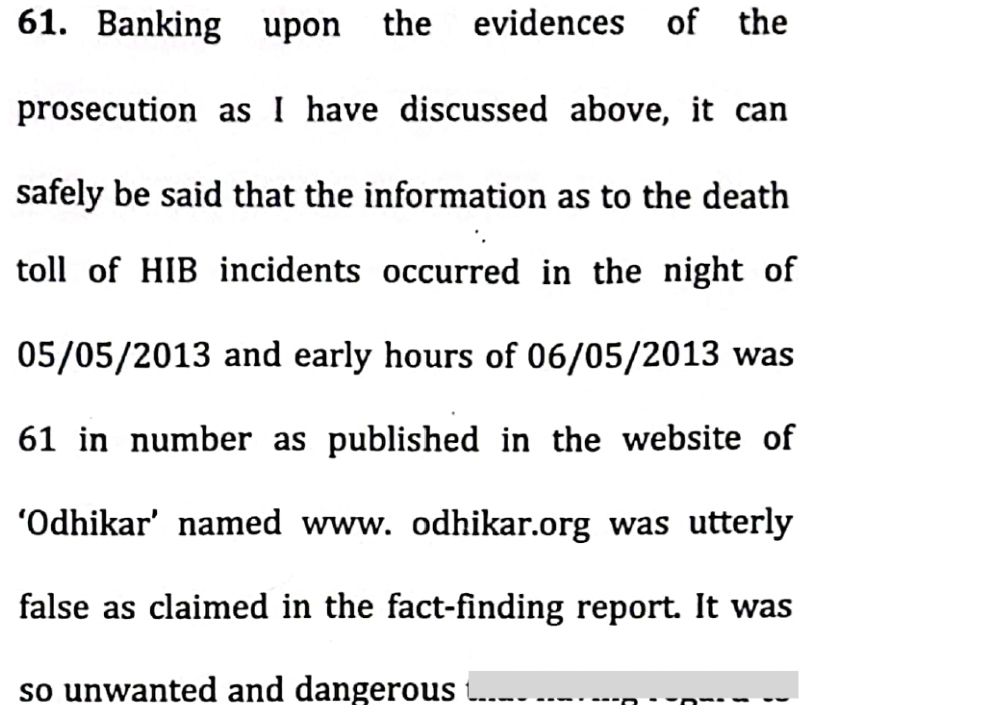A judicial misjudgement?
The written court judgement setting out reasons why it was right to convict two Bangladesh human rights activists reveals the absence of evidence to support its conclusions.

It is unlikely that many people have actually read the written judgement given by Judge AM Julfikar Hyat of Bangladesh’s cyber court on September 14th 2023, setting out the reasons why he convicted — and sentenced to prison — Adilur Rahman Khan and ASM Nasiruddin Elan, two senior officials of Odhikar, a prominent human rights organisation in Bangladesh.
The men had been charged under section 57 of the Information and Communications Technology Act following the publication in June 2013 of a report into clashes a month earlier between the law enforcement authorities and Hefazat-e-Islam. The clashes followed a rally that the Qawmi madrasa-based ultra-conservative Islamic group had organised in the centre of the capital city.
The criminal case and conviction centred around the report’s contention that 61 people died during the clashes on the night of March 5th 2013 and the following early morning.
However, a close reading of the judgement raises serious questions about the legitimacy of the guilty verdict.
This is because the judge himself ruled that only six names out of 61 were false, leaving the remaining 55 names uncontested. This shows that contrary to media reporting of this whole case, even on the judge’s own terms, there is only a relatively small level of error within the report.
This is significant to prove the offence.
The prosecution must proceed to show that a reading of this level of error within the report would have “prejudiced the image of the state” or “instigated someone” to commit violence or could or did result in the “deterioration of law and order”.
Yet the prosecutors did not provide any evidence in court to support this contention, which would be crucial to proving the case, and the judge did not set out in any detail why he concluded any of these three outcomes were caused by the six-name error in the report.
The offence and prosecution case
As stated earlier, Adilur Rahman Khan and ASM Nasiruddin Elan were charged with Section 57 of the ICT Act. This requires prosecutors to prove beyond reasonable doubt that the online report was either:
(a) “false and obscene”, or
(b) had an effect that “tended to deprave and corrupt persons”, or
(c) “causes to deteriorate or creates possibility to deteriorate law and order”, or
(d) “prejudices the image of the state or person”, or
(e) “causes to hurt or may hurt religious belief”, or
(f) “instigated against any person.”
The prosecution’s argument was that a) the report was false and b) this falsity resulted in one or other of the outcomes set out above.
The prosecutors put their case this way:
“[the two men] with ulterior motive along with a view to deteriorating further law and order and prejudicing the image of Bangladesh and also hurting the religious belief of Muslim community published two untrue reports […] claiming among others that 61 activists of HIB have died due to clashes between HIB and the law enforcement agencies.” (p.10, judgement. HIB refers to Hefazet-e-Islam).
In effect, to convict, the prosecution had to show, beyond a reasonable doubt, not only that the report was false but also that it was sufficiently false so that it could result in one of these impacts.
Interestingly, the prosecution claims that the men published the report with an “ulterior motive”, even though the offence does not appear to require a prosecutor to prove that the men intended these consequences. In any case, no evidence was presented by the prosecutor to prove that.
Falsity of the report
The prosecution said that the report’s finding that it had “found the names of 61 people who were killed” was false, and the real figure was 11, as put forward by the government.
The Odhikar report itself lists 16 of the 61 people whom it claimed had died in the report. These 16 names are of those people whose bodies were taken to the mortuary of Dhaka Medical College and Hospital and were subject to a post-mortem on 6/7 May (“two were policemen, two were Border Guard Bangladesh (BGB) men, and 11 others were civilians”). The report does not, however, mention any of the remaining 45 names it claims were killed.

The prosecution case was that although the 61 names were not set out in the report, it found a list of 61 names in a document on one of Odhikar’s computers, which had been seized from the group’s office. Prosecutors claimed that this list was the basis for the report's claim that 61 people had died - and that it was this list which was inaccurate, containing names of people who had not died or had not died in or immediately after the rally.
The defence lawyers rejected this argument and said the document on the computer was just a draft list but did not provide any other final list. The judge accepted the prosecution's argument that the computer list was the basis for the number “61” in Odhikar’s report.
Although the prosecutors claimed that the names of “50 people [on the list] were fake” (p.79), it did not present evidence to support this allegation. The 12 relevant prosecution witnesses only provided evidence that 8 out of the 61 names were incorrect.
Moreover, the judge did not accept all the prosecutor’s evidence. He held that the prosecution had not proven that two of these eight names (those of Md Al Amin and Hafez Lokman) were inaccurate and concluded instead that only 6 of the 61 cases were “false”.

Sufficiently false?
So, according to the judge, the falsity of the Odhikar report amounted to saying that there were 61 deaths. This means that 55 deaths on the list were not proven to be false.
To convict the two men, it was not enough for the prosecutors to prove that the report was just false. Section 57 of the ICT Act also requires them to provide beyond reasonable doubt that this level of falsity had at least one of the four outcomes as set out above.
However, the 155-page judgement shows that the prosecutors themselves did not present any evidence to support the contention that this was the case. Indeed, the only evidence given at the trial on this issue went against this contention. Detective Branch officer Ashraful Islam said when he was cross-examined that “he did not” know whether there were any “protests […] by Muslims” following the “publication of the report” and that “he did not know whether any indications or documents were found” showing that image “of the state were tarnished”. (p.25)
The judge himself noted this very point in relation to the question of whether the falsity had “prejudiced the image of the state”. He said in the judgement: “How the image of the state was tarnished was not clearly depicted either by PW1 or by PW18. Even PW22 did not say anything in this aspect.” (p.137. PW stands for “prosecution witness”).

In relation to the other three alleged outcomes (worsening of law and order, causing religious hurt, and provoking someone), the judge made no comment about the failure of the prosecution to present any evidence, though it was conspicuously absent.
In a situation as here, when the prosecution produces no evidence that a crucial element of an offence has been committed, how then does a judge rule that the accused is guilty? Here is what happened.
First, even though the judge had ruled that there was only evidence of six mistakes in the number of deaths, he described the report as “utterly false” and “so unwanted and dangerous” (p.144).

In using these words, the judge is, as we have seen, contradicting his own findings. It is not accurate to describe a report as being “utterly false” and “so unwanted and dangerous” when only 6 out of a list of 61 names are said to be false.
So why did he say that? Arguably, it was only by using such sensational language that he could seek to justify that it was right to convict.
The judge then goes on to conclude that the report’s falsity did result in all the outcomes. In relation to the question of “deterioration of law and order”, he says that:
“having regard to all relevant circumstances that prevailed on 5/5/2013 and onwards there were practical possibilities that by seeing their report anyone may cause to deteriorate or would create possibility to deteriorate law and order situation during that time.”
The judge does not explain the “practical possibilities” that could have linked, on the one hand, the “seeing” or “reading” of the report and, on the other hand, causing deterioration of law and order or its possibility.
The judge does provide what he calls an “indication” of why he thought the Odhikar report could have this effect - the deaths of two garment workers, Sadeq Miah and Md Rubel, who were killed in a clash between law enforcement officers and Hefazat-e-Islam on May 6th (p.144). He, however, does not explain how the particular conflict on 5/6 May 2013 between Hefazat-e-Islam and the law enforcement agencies, which resulted in these two deaths, is an “indication” of what might happen over one month later when someone reads a report about the violence at the rally. These outcomes are not connected at all.
Indeed, it should be noted that the publication of the report did not, in fact, have any negative impact on law and order.
The judge also stated, in relation to “instigation”, that “this situation may at any time also instigate the HIB organisation” (p.145). “This situation” here means the reading of the report, and “instigate” here means “instigates to violence”. Again, the judge does not explain how this could happen, how a report stating that there were 61, instead of 55 deaths, could “instigate” the organisation to violence. It is particularly problematic to think this since Hefazat-e-Islam thought the number should be much higher, not lower, than Odhikar’s finding of 61 deaths.
And of course, again, we also know that the report, when published and read by Hefazet-e-Islam and others, did not instigate the organisation or individual members of it.
The judge also concluded that “any false information in the public domain is nonetheless injurious for the honour of the state” (p.145). On this point, he had earlier stated:
“it is to some extent an abstract phenomenon, but something false or untrue relating to the responsibility of several state actors like law enforcement agencies are injurious for the state.” (p.138)
However, surely this is not enough to prove this case. The context is highly relevant as to whether the reputation of the state has been “prejudiced” (the actual word used in section 57.) The government and prosecution are claiming that 11 people died.
One can see how the state’s reputation could have been prejudiced had the prosecutors been able to prove that 50 of the 61 names on the list were false. But they were not able to do that. They were only able to prove that 6 out of 61 names were false. In effect, that means that if the report had stated that 55 people had died, it would not have been inaccurate, and the state’s reputation would not have been prejudiced.
So how could the act of reporting a number six higher than 55 "prejudice" the state?
Miscarriage of justice
It is clear that the evidence presented at trial, in tandem with the factual findings by the judge, does not justify the conviction of the two men. Effectively, this was a judgement written to obtain a conviction irrespective of the evidence before the court and the judge’s own findings on that evidence.
Either this judgement is the result of a very significant lack of professionalism on the part of the judge or because he was told or knew that he had to convict the two men. We will leave it to others to determine the best explanation.
Whichever of these two explanations proves true, any competent court of appeal should be able to see the significant gaps in the evidence and legal analysis in the court judgement. It is now up to the rest of Bangladesh’s judicial system to show some courage, do what is right, and acquit the two men.
Adilur and Elan have now got bail. One can only hope that this conviction will be quickly reversed.●